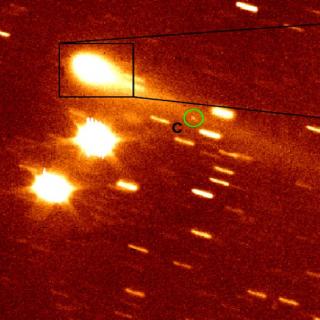Bibcode
Devogèle, Maxime; McGilvray, Anna; MacLennan, Eric; Monchinski, Courteney; Marshall, Sean E.; Hickson, Dylan; Virkki, Anne; Giorgini, Jon D.; Abe, Lyu; Augustin, David; Aznar-Macías, Amadeo; Baudouin, Philippe; Behrend, Raoul; Bendjoya, Philippe; Benkhaldoun, Zouhair; Bosch, Josep; Cellino, Alberto; Chatelain, Joseph; Deldem, Marc; Ferrais, Marin; Goncalves, Rui; Houdin, Gerard; Husárik, Marek; Jehin, Emmanuel; Kareta, Teddy; Kim, Myung-Jin; Licandro, Javier; Lister, Tim; Medeiros, Hissa; Pravec, Petr; Rivet, Jean-Pierre; Rousseau, Gerald; Roh, Dong-Goo; Skiff, Brian; Taylor, Patrick A.; Venditti, Flaviane; Vernet, David; Vienney, Jean-Michel; Yim, Hong-Suh; Zambrano-Marin, Luisa
Referencia bibliográfica
The Planetary Science Journal
Fecha de publicación:
2
2024
Número de citas
2
Número de citas referidas
2
Descripción
On 2020 April 29, the near-Earth object (52768) 1998 OR2 experienced a close approach to Earth at a distance of 16.4 lunar distances (LD). 1998 OR2 is a potentially hazardous asteroid of absolute magnitude H = 16.04 that can currently come as close to Earth as 3.4 LD. We report here observations of this object in polarimetry, photometry, and radar. Our observations show that the physical characteristics of 1998 OR2 are similar to those of both M- and S-type asteroids. Arecibo's radar observations provide a high radar albedo of ${\hat{\sigma }}_{\mathrm{OC}}\,=$ 0.29 ± 0.08, suggesting that metals are present in 1998 OR2 near-surface. We find a circular polarization ratio of μ c = 0.291 ± 0.012, and the delay-Doppler images show that the surface of 1998 OR2 is a top-shape asteroid with large-scale structures such as large craters and concavities. The polarimetric observations display a consistent variation of the polarimetric response as a function of the rotational phase, suggesting that the surface of 1998 OR2 is heterogeneous. Color observations suggest an X-complex taxonomy in the Bus–DeMeo classification. Combining optical polarization, radar, and two epochs from the NEOWISE satellite observations, we derived an equivalent diameter of D = 1.80 ± 0.1 km and a visual albedo p v = 0.21 ± 0.02. Photometric and radar data provide a sidereal rotation period of P = 4.10872 ± 0.00001 hr, a pole orientation of (332.°3 ± 5°, 20.°7 ± 5°), and a shape model with dimensions of
$({2.08}_{-0.10}^{+0.10},{1.93}_{-0.10}^{+0.10},{1.60}_{-0.05}^{+0.05})$ km.
Proyectos relacionados

Pequeños Cuerpos del Sistema Solar
Este Proyecto estudia las propiedades físicas y composicionales de los llamados pequeños cuerpos del Sistema Solar, que incluyen asteroides, objetos helados y cometas. Entre los grupos de mayor interés destacan los objetos trans-neptunianos (TNOs), incluyendo los objetos más lejanos detectados hasta la fecha (Extreme-TNOs o ETNOs); los cometas, y
Julia de
León Cruz